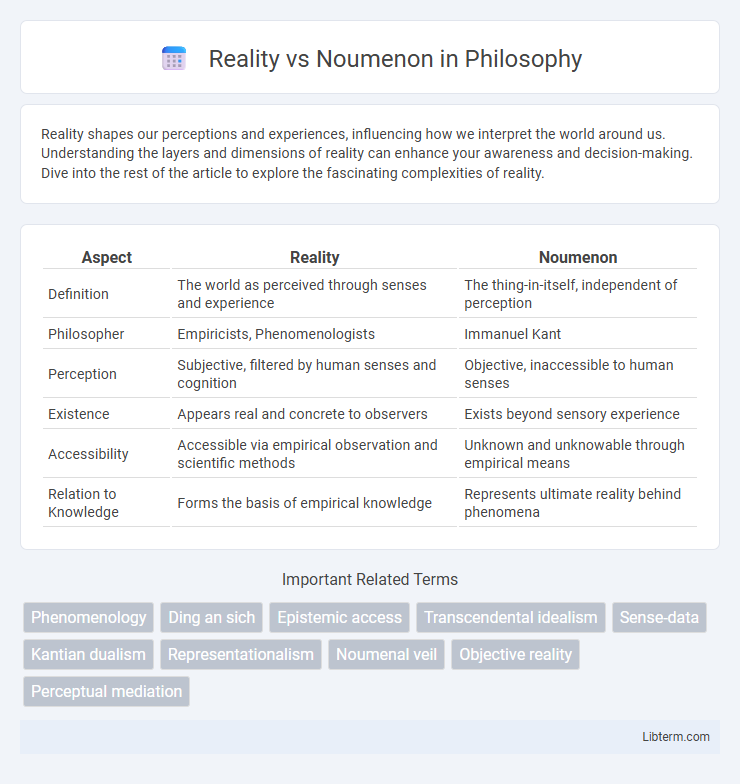Reality shapes our perceptions and experiences, influencing how we interpret the world around us. Understanding the layers and dimensions of reality can enhance your awareness and decision-making. Dive into the rest of the article to explore the fascinating complexities of reality.
Table of Comparison
| Aspect | Reality | Noumenon |
|---|---|---|
| Definition | The world as perceived through senses and experience | The thing-in-itself, independent of perception |
| Philosopher | Empiricists, Phenomenologists | Immanuel Kant |
| Perception | Subjective, filtered by human senses and cognition | Objective, inaccessible to human senses |
| Existence | Appears real and concrete to observers | Exists beyond sensory experience |
| Accessibility | Accessible via empirical observation and scientific methods | Unknown and unknowable through empirical means |
| Relation to Knowledge | Forms the basis of empirical knowledge | Represents ultimate reality behind phenomena |
Defining Reality and Noumenon
Reality encompasses all phenomena perceived through the senses and empirical observation, forming the objective world accessible to human experience. Noumenon, a concept rooted in Kantian philosophy, refers to the "thing-in-itself," an underlying essence that exists independently of sensory perception and remains inherently unknowable. Distinguishing reality as the observable realm and noumenon as the inaccessible core emphasizes the limits of human cognition and the metaphysical divide between appearance and essence.
Historical Roots of the Noumenon Concept
The noumenon concept originates in Immanuel Kant's critical philosophy, wherein it signifies the "thing-in-itself" (Ding an sich) beyond human sensory experience, contrasting with phenomena accessible to human cognition. Its roots can be traced to ancient Greek philosophy, particularly Plato's theory of Forms, which posited an intelligible realm of ideal entities distinct from the material world. Kant's noumenon redefined metaphysical inquiry by emphasizing epistemological limits, asserting that while phenomena are knowable through experience, noumena remain fundamentally inaccessible to sensory perception and empirical knowledge.
Kantian Philosophy: Phenomena vs. Noumena
Kantian philosophy distinguishes between phenomena, the world as experienced through human senses and cognitive faculties, and noumena, the reality that exists independently of perception, which remains inherently unknowable. Phenomena are structured by a priori categories of understanding, making empirical knowledge possible, whereas noumena represent the "things-in-themselves" (Dinge an sich) beyond sensory experience. This distinction underscores Immanuel Kant's critical epistemology, emphasizing the limits of human knowledge confined to appearances, while noumena signify the metaphysical substrate inaccessible to direct cognition.
Sensory Experience and Perception of Reality
Sensory experience shapes our perception of reality by filtering external stimuli through the senses, yet this perception is inherently limited to phenomena, the objects as they appear to us. Noumenon, or the thing-in-itself, exists independently of sensory experience and remains inaccessible, highlighting the distinction between observed reality and its underlying essence. This gap underscores philosophical inquiries into how much of reality is constructed by perception versus how much exists beyond human cognition.
Limits of Human Cognition
Human cognition is inherently limited by the boundary between reality as it appears to us and the noumenon, or the thing-in-itself, which remains inaccessible to direct experience. Our perception and understanding are constrained by sensory input and mental frameworks, preventing us from fully grasping the true essence of objects beyond phenomena. Kant's philosophy emphasizes that while we can know appearances, the noumenal reality exists beyond the limits of human cognitive faculties.
Scientific Approaches to Reality
Scientific approaches to reality emphasize empirical observation, measurement, and experimentation to understand phenomena that can be perceived and tested. Reality is defined by objective data and reproducible results, contrasting with noumenon, which represents things-in-themselves beyond sensory experience and scientific verification. Modern physics explores aspects of reality that challenge classical notions, yet empirical science remains grounded in observable and measurable evidence.
Noumenon in Eastern Philosophical Traditions
In Eastern philosophical traditions, noumenon often corresponds to the concept of ultimate reality beyond sensory perception, as seen in Advaita Vedanta's Brahman or Buddhist Sunyata (emptiness). These philosophies emphasize that noumenon is an ineffable, transcendent reality that underlies and transcends all phenomena, which are illusory or impermanent. Meditation and direct experience are key methods in these traditions for apprehending the noumenal truth beyond the realm of empirical reality.
The Role of Language in Shaping Reality
Language fundamentally shapes our perception of reality by categorizing sensory experiences into comprehensible concepts, bridging the gap between noumenon--the thing-in-itself--and phenomenon, the thing as it appears. Linguistic structures influence cognitive frameworks, determining how individuals interpret and interact with the world, thereby constructing subjective realities that may not reflect objective noumenal essence. The limitations and affordances of language play a critical role in mediating knowledge, meaning that reality as experienced is inseparable from the semantic and syntactic properties of language.
Reality, Noumenon, and Modern Metaphysics
Reality in modern metaphysics is often contrasted with noumenon, where reality refers to the world as it appears through empirical observation and sensory experience. Noumenon, a concept originating from Kantian philosophy, represents the thing-in-itself, an underlying essence inaccessible to direct human cognition and distinct from phenomena. Contemporary metaphysical debates explore the limits of human understanding, emphasizing the distinction between observable reality and the unknowable noumenal realm to address questions of existence, perception, and truth.
Implications for Truth and Knowledge
Reality, as perceived through sensory experience, contrasts with noumenon, the thing-in-itself beyond human cognition, emphasizing the epistemological limits inherent in understanding truth. The distinction challenges the assumption that empirical observation alone can yield objective knowledge, suggesting that truth may be inherently inaccessible or conditioned by human perception. This philosophical divide underpins critical debates about the nature of knowledge, the possibility of metaphysical certainty, and the role of cognition in shaping reality.
Reality Infographic

 libterm.com
libterm.com